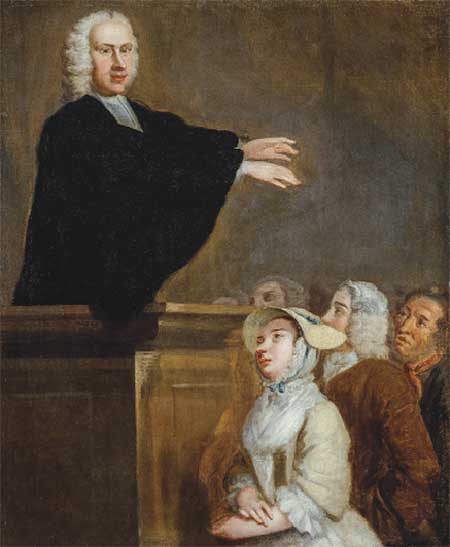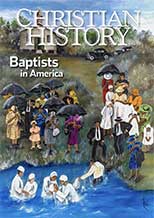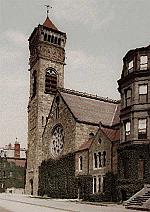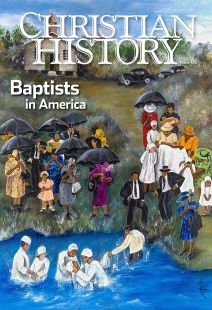From outlaws to patriots

George Whitefield preaching. British Museum.
On September 5, 1651, Obadiah Holmes was taken from his cell in Boston’s prison to receive 30 lashes with a three-corded whip. Holmes had been alone in prison for weeks; that day an unusual calm came over him. His captors tried to keep him from speaking, but he would not be silent. “I am now come to be baptized in afflictions by your hands,” he said, “that so I may have further fellowship with my Lord, and am not ashamed of his sufferings, for by his stripes am I healed.”
Holmes was tied to a post; an officer took up the whip and began flailing with all his might. Yet Holmes felt God’s presence more strongly than at any other time in his life; the pain floated away. When the captors untied him, Holmes stood up and smiled. “You have struck me as with roses,” he advised them.
What had Holmes done to provoke the wrath of colonial Massachusetts? He had preached the gospel of the Baptists. And that was against the law.
Baptist beginnings in England
Baptists argued that their defining practice—the baptism of Christian believers by immersion—represented a recovery of ancient Christian tradition. Hints of a Baptist movement existed in sixteenth-century England, mostly among English Separatists, radical Puritans who believed that the Church of England was corrupt beyond redemption. By the early seventeenth century, some Separatists concluded that complete church purity demanded a rejection of infant baptism.
Many of them also adopted views similar to Mennonites on issues such as separation of church and state, and experienced similar persecution by political and church authorities. Fleeing such persecution, Separatist pastor John Smyth (c. 1570–1612), originally an Anglican priest, escaped to Amsterdam in 1608. Taking his rejection of church tradition to the furthest extreme, Smyth decided to baptize himself by affusion (pouring water over his head) and subsequently baptized the rest of his congregation. Then he developed doubts and approached local Mennonites to baptize him (for what would have been the third time). They refused.
Smyth soon died of tuberculosis, and his followers split. Some joined the Mennonites, some followed John Robinson’s English Separatists (the “Pilgrims” on the Mayflower in 1620), and a small faction, nicknamed “se-Baptists” (self-Baptists), followed lawyer Thomas Helwys (c. 1550–c. 1616). They returned to England in 1611 or 1612, where Helwys gained notoriety with his Short Declaration of the Mystery of Iniquity (1612).
Short Declaration, personally inscribed for King James I with a remarkable tirade against state authority in spiritual matters, landed Helwys in London’s infamous Newgate Prison, where he died. Despite their untimely ends, Smyth and Helwys had permanently established the Baptist movement in England.
“the se-baptist at amsterdam”
Most early American colonists were at least nominally Christian; almost all practiced infant baptism, viewing its rejection as a dangerous affront to the traditions of family, church, and society. In the Puritan-founded colony of Massachusetts, Roger Williams was one of the first to run afoul of these strictures.
Arriving in Massachusetts in 1631 as a Separatist pastor, Williams’s continual dissent took him from Boston to Plymouth to Salem. In Plymouth a ruling elder feared Williams “would run the same course of rigid separation and anabaptistry, which Mr. John Smith, the se-[self] baptist at Amsterdam had done.”
In 1636 Williams fled to southern New England and helped establish the town of Providence and the colony of Rhode Island, soon filled with Separatists. Meanwhile the mercurial Williams repudiated his infant baptism and in 1638 joined with a small group of followers to establish America’s first Baptist church in Providence. One of Williams’s followers, Ezekiel Holliman, baptized him, and then Williams baptized Holliman and the rest of the group. Like John Smyth, though, Williams began to question his new baptism. From that point forward, he preached to anyone who would listen, but he refused to join a church.
Persecution of Baptists soon intensified. Provocative behavior by some Baptists was partially responsible. William Witter was brought before the court of Salem, Massachusetts, in 1643 for saying that infant baptism was “a badge of the whore” and three years later “for saying that they who stayed while a child is baptized, do worship the devil.” Massachusetts authorities banned Baptists in 1645, calling them “the incendiaries of commonwealths and the infectors of persons in main matters of religion, and the troublers of churches in all places.” The ban covered anyone who questioned infant baptism, proclaimed Christian pacifism, or denied the state’s authority to police religious convictions.
In 1654, though, the Baptists nabbed their most prominent colonial convert: Harvard president Henry Dunster. His public rejection of infant baptism alarmed Massachusetts authorities, but they had to handle the case delicately; the president of Harvard could not be hastily tried or summarily whipped.
A group of Puritan ministers met with Dunster, but he made compelling arguments for believer’s baptism. “All instituted gospel worship hath some express word of Scripture,” he said. “But paedobaptism hath none.” Harvard removed him from the presidency. After his dismissal Dunster largely remained quiet, but he presented a formidable challenge to the Massachusetts establishment, simply because he had once belonged to it. It seemed anyone could be led astray by the Baptists.

Buy Christian History #126 Baptists in America.
Subscribe to Christian History.
Baptists in Boston
Meanwhile Boston farmer and wagon maker Thomas Goold (1607-1675) had become intrigued by Baptist beliefs. When the family had a daughter in 1655, he refused to present her for the customary baptism. Eight years later he objected when his church adopted the Halfway Covenant, a Puritan agreement to allow baptized nonmembers to have their children baptized despite lack of a convincing testimony of conversion by the parents.
Goold and others began holding private meetings at his home; they solidified their Baptist convictions in May 1665 when Goold and eight others were immersed. Massachusetts authorities would normally have crushed Goold, but ongoing controversy related to the Halfway Covenant, as well as the English government’s pressure to temper persecution in the wake of recent Quaker hangings, muted their reaction.
Goold was excommunicated and tried twice but not successfully convicted; then the government challenged Baptists to an unprecedented public debate in 1668. When the debate ended without changing Baptist minds, the Massachusetts General Court banished Goold and two others. Despite their best efforts, signs of Baptist activity began to appear all over eastern Massachusetts. In 1674 Goold and his followers slipped into Boston and began meeting at a private home.
Though Goold died in 1675, his church grew to 80 members by 1680. Officials tried repeatedly to stop their meetings, even nailing the door shut. But continuing pressure from London for religious toleration broke Boston’s resistance, and in 1681 the General Court gave official approval for them to meet publicly.
In 1689 new English monarchs William III and Mary II championed the Act of Toleration, which protected freedom of religion for all Protestants, including Baptists. Baptists could now worship in relative peace and quiet, but they still had to pay taxes to support the established state churches.
By the early eighteenth century, Baptist churches proliferated across America. In Kittery, Maine, a small church developed under the leadership of the merchant William Screven (c. 1629–1713); hoping for relief from persecution, Screven and a number of church members relocated to Charleston, South Carolina, and by 1696 established the first Baptist congregation in the South.
Quaker-founded Pennsylvania afforded religious
freedom to all, but this actually worked against Baptists: they struggled to get a foothold amid so many churches and sects while troubled by internal feuds. To alleviate these problems, the Philadelphia Association of Baptists was founded in 1707. The association could not dictate policy or theology to individual congregations, but it helped regularize Baptist life in the Middle Colonies—solving congregational disputes, testing ministerial candidates, and sponsoring new churches and missionary journeys.
The largely uneducated leaders of the seventeenth century were gradually replaced by highly educated pastors in the eighteenth. In 1718 Elisha Callender became the first Harvard-educated pastor of Boston’s First Baptist Church. Congregationalist stalwarts such as Cotton Mather even participated in his ordination.
Great Awakenings
The next big break for Baptists came from an unlikely source: popular Anglican revivalist George Whitefield, whose fiery preaching drew large crowds. During a 1740 stop in Philadelphia, Whitefield heard Baptist pastor Jenkin Jones preach “the truth as it is in Jesus” and called him “the only preacher that I know of in Philadelphia, who speaks feelingly and with authority.”
But one of the Baptists who most vehemently opposed the revivals was Ebenezer Kinnersley, an assistant to Jones. Kinnersley grew increasingly uncomfortable with the revivals’ emotional extremes, and a frenzied sermon preached at the Baptist church by Presbyterian revivalist John Rowland pushed him over the edge. The disgusted Kinnersley went public with his complaints in Ben Franklin’s Pennsylvania Gazette.
Franklin knew a good news story when he saw one, and he became the colonies’ most influential publicist of the Great Awakening, giving a platform both to Whitefield and to his critics. This story was repeated all over as hundreds of new “Separate” Congregationalist and Baptist churches formed, usually because existing churches did not sufficiently support revivals.
The most influential New England Baptist convert to emerge from the Great Awakening was Isaac Backus, from a Congregationalist farming family in Norwich, Connecticut. When the revival came, Backus’s mother renewed her faith and urged her son to do the same. His breakthrough came in late August 1741:
The justice of God shined so clear before my eyes in condemning such a guilty rebel. . . . And just in that critical moment God who caused the light to shine out of darkness, shined into my heart with such a discovery of that glorious righteousness which fully satisfies the law that I had broken. . . .
Backus became increasingly dissatisfied with his Norwich church. By mid-1745, 13 members, including Backus, stopped attending and began holding private meetings; they argued that the church did not make conversion a condition of membership and that “the gospel is not preached here.”
The 23-year-old Backus had no college education or formal ministerial training, but during a 1747 visit to Titicut, Massachusetts, he felt moved by the Holy Spirit to a ministerial calling. His commitment to that calling would last the rest of his life. In July 1751 Backus set apart a day for fasting and prayer to consult every Bible verse relevant to baptism and definitively concluded that baptism was for believers, not infants. He announced this conclusion to his church, which led some to discuss removing him as pastor. In August he took the final step of receiving believer’s baptism from a visiting Baptist pastor.
Starting unauthorized churches was illegal, and Separates and Baptists experienced severe persecution in New England, usually for their refusal to pay taxes to support the established churches; Backus’s own mother and brother were imprisoned in 1752 for this offense. Some suffered physical violence.
One provocative Baptist preacher in Connecticut, Joshua Morse, faced repeated beatings and harassment from both government officials and angry mobs. On one occasion he was dragged by the hair out of a revival service, down a flight of steps, and into the street. He was beaten severely and received a gash on his face that scarred him for life. Official and unofficial persecution undoubtedly hindered Baptist growth in New England. But it also increased Baptist zeal.
Whitefield also brought revival and turmoil to Baptists in the South. Following the 1690s establishment of Charleston’s First Baptist Church, Baptists had spread through the Carolina low country. A pivotal congregation was formed on the Ashley River north of Charleston, where English Baptist Isaac Chanler became minister in the 1730s.
“A public bath”
In July 1740 Whitefield began preaching at Ashley River, describing Chanler as a “gracious Baptist minister.” Whitefield had become so disgusted with the Anglicans of Charleston that he “went to the Baptist and Independent meetinghouses, where Jesus Christ was preached” and privately served Communion to sympathetic Anglicans, Presbyterians, and Baptists. (Later an unsympathetic Anglican priest, Charles Woodmason, would criticize revivalism and Baptist public baptisms, “to which lascivious persons of both sexes resort, as to a public bath.”)
The key figure in exporting the Separate Baptist movement to the South was Shubal Stearns (1706–1771) of Connecticut. Converted by Whitefield, Stearns and his family adopted Baptist principles and in 1754 left for North Carolina.
In Sandy Creek they established a church that grew to more than 600 members. It spawned 42 congregations within 17 years, becoming the epicenter of Baptist revival in the South. Stearns and his followers experienced intense signs and wonders. They preached in a deeply emotional style that generated crying, shaking, and visions. Stearns himself developed a quasimystical reputation.
The Sandy Creek churches looked strictly to the Bible as their guide for church practice, implementing even obscure New Testament obligations. They practiced nine rites. The first two were believer’s baptism and the Lord’s Supper celebrated weekly. But the other seven were less common in colonial America: love feasts, laying on of hands at baptism, foot washing, anointing the sick with oil, the right hand of fellowship, the kiss of charity, and devoting infant children, a substitute for infant baptism.
Elders governed Sandy Creek churches; deacons cared for congregational needs. Remarkably women commonly served in both offices. Eldresses, as they were called, primarily worked with women but occasionally taught mixed audiences. Unlike many Anglicans, Separate Baptists evangelized slaves and sometimes gave blacks positions of leadership as exhorters, deacons, and even elders in mixed-race congregations.
Separates in the North, though, were growing in sophistication and in similarity to the more established Philadelphia Association. The 1764 founding of Brown University in Rhode Island and the organization of a New England group of Baptists called the Warren Association in 1767 further enhanced the move toward the mainstream.
But full religious liberty still tarried. In Ashfield, Massachusetts, in 1770, authorities seized hundreds of acres from Baptists who did not support the Congregational Church. The Warren Association appealed directly to King George III, who sided with the Baptists. Ashfield’s Baptist minister called the Sons of Liberty, who led the resistance against Britain, undeserving of their name: they only wanted “liberty from oppression that they might have liberty to oppress!”
One of the most influential Baptist Patriot resistors was also one of the most unlikely. In 1772 English Baptist pastor John Allen arrived in Boston from London (where he had just lost his job) and became one of the resistance’s most popular advocates with his An Oration upon the Beauties of Liberty. In contrast to most colonists who blamed British bureaucrats, Allen pointed directly at the king himself:
I distinguish greatly between a king and a tyrant, a king is the guardian and trustee of the rights and laws of the people, but a tyrant destroys them.
This was heady, seditious stuff—three years ahead of Thomas Paine’s Common Sense.
At the outbreak of the Revolution, rank-and-file Americans, including Baptists, carried on their daily business, often not learning of major developments until days or weeks later. The only journal entry Baptist pastor Hezekiah Smith made on the weekend the Declaration of Independence was signed was a passing remark about his health. But Smith soon became one of the first chaplains hired by the Continental Congress.
great men with hats of feathers
The South Carolina Patriot assembly sent Baptist pastor Oliver Hart of Charleston on a backcountry recruiting campaign to convince reluctant settlers to embrace the Revolution. Hart found that some thought Bostonians had recklessly stirred conflict; one man said he didn’t care if “1,000 Bostonians might be killed in battle.” James Miles of North Carolina criticized Patriot leaders: “Show him a great man with a half-moon in his hat with liberty written upon it and his hat full of feathers . . . and he would show you a devil.”
But the Separate Baptists of Virginia declared in 1775 that although they had many religious differences with their fellow Americans, they shared the same political cause of liberty. They advised “military resistance against Great Britain in her unjust invasion, tyrannical oppression, and repeated hostilities.”
The Philadelphia Association took a more muted tone, worrying over the “awful impending calamities” of war and recommending that congregations hold days of fasting to pray for God’s help and forgiveness for America’s sins. The war did hold “awful impending calamities” for many Americans; numerous churches were damaged, disrupted, and scattered by the conflict. Charleston’s First Baptist Church essentially ceased to function for two years after the city fell to the British.
The First Continental Congress in Philadelphia in 1774 presented a chance for Baptists to appeal directly to Patriot leaders for religious liberty. The Warren Association distributed An Appeal to the Public for Religious Liberty to members of Congress and sent Backus and James Manning to Philadelphia to lobby for their cause. In October 1774 they met with leaders of the Massachusetts delegation, including Samuel and John Adams, and presented a case for religious liberty and disestablishment (see “The wall of separation,” pp. 13–15).
As the war progressed, many Baptists began to identify America as a nation specially blessed by God. Hezekiah Smith traveled with General Horatio Gates’s troops as they faced the lumbering army of British general John Burgoyne in New York in 1777. Smith ministered to American troops and watched them win the Battle of Freeman’s Farm. He captured the experience in a sermon on Exodus 15:2: “The Lord is my strength and song, and he is become my salvation.”
Manning had received the war’s beginning with much trepidation, but he and Backus heralded its conclusion as a sign from heaven. This growing Baptist enthusiasm for the new country was perhaps best expressed by the Warren Association in 1784:
The American Revolution . . . has been accomplished by many astonishing interpositions of Providence. . . . Nor is it at all improbable, that America is reserved in the mind of Jehovah, to be the grand theater on which the divine Redeemer will accomplish glorious things.
Baptists hoped that victory over tyranny would be followed by full religious liberty. They had come a long way from their dissenting English roots and their days as colonial outlaws; they had become Americans. CH
By Thomas S. Kidd and Barry Hankins
[Christian History originally published this article in Christian History Issue #126 in 2018]
Thomas S. Kidd is Distinguished Professor of History at Baylor University and the author of books on evangelical Christianity and colonial history. Barry Hankins is professor of history at Baylor. This article is adapted from their book Baptists in America.Next articles
Editor’s note: Baptists in America
Graham’s crusades and King’s struggles are seen as bigger than any one denomination. . . . a lot of Baptist stories are like that.
Jennifer Woodruff TaitWhich Baptist are you again?
What is behind the names of all those Baptist branches?
Elizabeth FlowersSupport us
Christian History Institute (CHI) is a non-profit Pennsylvania corporation founded in 1982. Your donations support the continuation of this ministry
Donate





